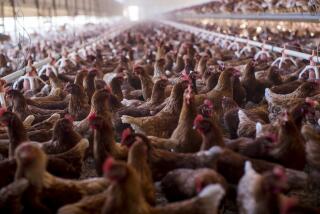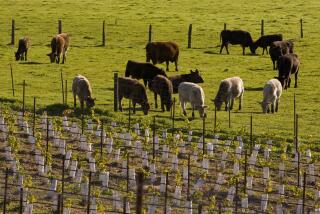EPA Proposes Stiffer Rules to Curb Livestock Waste
- Share via
WASHINGTON — The Environmental Protection Agency proposed tougher requirements Friday on thousands of large animal feedlot operations, declaring that they are one of the country’s chief causes of water pollution.
The proposed regulations, which will depend on decisions made by the Bush administration, would expand the number of cattle feedlots and hog farms that would have to get pollution permits. It also imposes new pollution control requirements on large poultry operations.
EPA Assistant Administrator Walter J. Charles Fox said that large factory farms are “among the greatest threats to our nation’s waters and drinking water supplies” because of the large amounts of manure they produce in concentrated areas.
Some environmentalists criticized the EPA proposal as not going far enough to clean up large hog, poultry and cattle farms. For example, they said, the EPA proposal stopped short of banning the use of open lagoons for wastes. It also allows for continued spraying of manure on fields as fertilizer.
“It will be business as usual for industrialized agribusiness,” predicted Nancy Stoner, director of the Clean Water Project for the Natural Resources Defense Council. The NRDC sued the EPA eight years ago, accusing it of not moving aggressively against large corporate farms, winning a consent agreement.
Over the past 20 years the livestock industry has dramatically consolidated, with small farms replaced by large feeding operations for cattle and hogs.
The result has been a growing concentration of animal waste, often kept in large open lagoons, some the size of a football field. In other cases excessive amounts of waste are spread on fields, causing chemical and nitrogen runoff into lakes, streams and estuaries and resulting in fish die-offs and other problems.
The EPA’s proposed regulations, worked out with the Agriculture Department, would:
* Require stricter permit procedures for large livestock feedlots.
* Expand controls to some feedlots now exempted from state pollution controls, so that virtually all large livestock operations will have to seek pollution permits.
* Impose controls on waste discharge from storage pits and lagoons and limits on the amount of manure that can be spread on land owned by livestock facilities.
* Hold corporate owners of livestock or poultry responsible for proper waste disposal, no longer leaving that to contract farmers with little money to make environmental improvements.
The National Pork Producers Council has said that the industry is spending millions of dollars to find scientific answers to deal with pollution concerns and that producers “clearly recognize (their) responsibilities for a clean environment.”
The industry notes that Smithfield Foods Inc., the country’s largest hog producer, this summer reached agreement with North Carolina authorities to phase out open-air waste lagoons on its farms and is investing $65 million in research into new disposal methods.
Nevertheless, a group of environmental activists earlier this month announced a broad new campaign to file lawsuits against large hog operations in seven states to force them to improve waste disposal.
More to Read
Sign up for Essential California
The most important California stories and recommendations in your inbox every morning.
You may occasionally receive promotional content from the Los Angeles Times.










